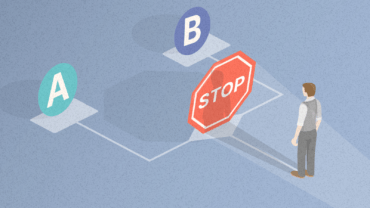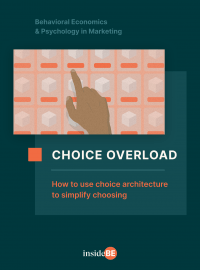Interview With Matej Sucha: First, You Need to Understand Why Your Customers Aren’t Doing What You Want Them to Do

“Only when we understand what’s going on in the customers’ heads after a thorough analysis can we start designing solutions,“ says Matej Sucha, MINDWORX´s CEO, and managing partner. In the first part of our interview, we’ll be discussing how he fell in love with behavioral science, what his role is in the company that he founded, and what kind of projects he’s usually working on.
In this interview, you’ll discover:
- Who and what got Matej Sucha into behavioral economics;
- What are the biggest mistakes that companies are making in marketing and sales; and
- What’s the first thing a company must address when faced with a problem?
When you look back over the years since you founded MINDWORX, what do you see?
I see an interesting journey and more than five and a half years of highly engaging projects and amazing people. But most importantly, I see proof that behavioral economics really does work and can yield astounding results in business.
Who or what got you into behavioral science?
It was a coincidence. I stumbled upon a book by a behavioral economist- Dan Ariely. I was studying mathematics at the time, but I had always been interested in business and entrepreneurship and was reading up on it a lot. By that time, I had also been reading Influence: Psychology of Persuasion by Robert Cialdini. I was hooked instantly. Basically from that moment on, I devoted much of my time to learning all that I could about behavioral economics (BE). I eventually ended up falling in love with BE and would dream about advising big companies and clients on how to use these insights to their advantage. So I decided to quit my job and founded MINDWORX.

Discover ground-breaking ideas and fascinating solutions.
Tell us more about your role as the MINDWORX founder and managing partner.
In the beginning, I was doing everything. From speaking and writing articles and blogs to business development, conducting training, and delivering projects. My role was constantly changing over time as the team continued to grow. Nowadays, I’m responsible for business development, holding talks, and building relationships with our clients. When it comes to projects, my role is more supervisory in nature where I play “the devil’s advocate.” I´m not involved in the project from beginning to end nor am I involved in every detail of the process. But I, of course, step in whenever necessary or whenever I feel I have something to contribute with my experience and insight. My current role gives room for me to explore new strategic projects like the MINDWORX Academy.
What kind of projects do you work on most often?
Most of our clients are banks and insurance companies. We also do some work for telecommunications companies and utilities. The assignments usually have to do with increasing conversions of sales funnels, changing communication, or improving customer experience. And aside from these projects, we also have a couple of projects where the goals have nothing to do with marketing or sales, but more about changing people’s behavior.
For instance, we have a client whose expertise is creating written and video testimonials of satisfied customers. There are a lot of parties involved that they need to coordinate with, and a common problem is that these parties are not very responsive or communicative. This can cause a whole slew of problems because if a third party isn’t answering their emails or respecting deadlines, then they miss their own deadlines too. And so, the whole thing can drag on for unbearably long lengths of time. We help the client “nudge” their collaborators to be more responsive and to respect the deadlines.
What’s the first thing you do when you encounter a problem the company is facing? In other words, what’s your rule number one and your first go-to response?
To never start by immediately coming up with solutions. We always start with what we call a “behavioral audit,” in which we try to understand the decision-making process of the customers we want to influence. Within this decision-making process of theirs, we must understand what motivates them at every step of the way and, more importantly, the barriers that discourage them from doing what we want them to do. Only when we understand what’s going on in the customers’ heads after a thorough analysis can we start designing and testing solutions.
We always start with what we call a “behavioral audit,” in which we try to understand the decision-making process of the customers we want to influence.
When the company or a firm gets stuck on something and can’t move forward, what’s your advice? What should they do first before asking for help from marketing consultants?
Probably, my biggest advice would be to try and figure out what’s standing in the customer’s way. What companies tend to focus on a lot is how they can motivate their clients to do what they want them to do. But this is often the wrong approach. All too often it’s not the lack of motivation that causes customer inaction: they’re generally motivated enough as it is. Instead, the problem lies in the amount of hurdles or barriers that they encounter along the way. And when I say barriers, keep in mind that these are not necessarily physical or objective. They can very well be psychological in nature as well.
One of the most important psychological barriers is uncertainty.
One of the most important psychological barriers is uncertainty. If I experience uncertainty, it means that I don’t have the necessary information I need at the right time. More often than not, such a case might result in me postponing my decisions or abandoning them altogether. Be it a registration process or a sales funnel. So the very first thing that a company should do is to understand the reasons why their clients or customers aren’t doing what they want them to do.
Can you tell me what the most common problems are that your clients are facing?
Many of our clients approach us when they get stuck. They’ve tried everything but nothing seems to work and they don’t know what else they can do. Most problems have to do with increasing conversions, redesigning online processes, improving direct communication, or reducing churn rates.
What are some of the biggest mistakes you see marketers making?
I’ll repeat what I mentioned earlier. People working in marketing and sales tend to focus more on how to motivate their customers. They talk about the benefits of their products, provide discounts, and prepare all kinds of special offers. But this is a fundamental mistake. Changing behavior has two key components. The first one is to increase motivation. The second one, which is often overlooked and yet arguably far more important than the first one, is to remove all barriers that block desired behavior.
Very seldom I see marketing and salespeople trying to figure out the “why not question.” I only see them focusing on the motivation side of the problem. Another thing I often see is that many marketing agencies think that creativity is what sells. This is simply not the case.
People talk about the benefits of their products, provide discounts, and prepare all kinds of special offers. But this is a fundamental mistake.
Why?
You can have a handful of beautiful commercials on TV that will cost you an arm and a leg, but they can be extremely ineffective. We were involved in a couple of projects where clients put together beautiful TV commercials. The music was perfect, the visuals were on point. Everything looked fantastic. But the problem was that it wasn’t clear what the purpose of the commercials was and what outcome and behavior they were trying to achieve.
After a test audience watched a 30-second commercial, we asked them about it and they were like: “Okay, cool commercial. I liked it. But what was the main message? Can I watch it again?” All in all, I would say that they think creativity and making beautiful things are more important than keeping it simple with a clear, easy-to-understand, and effective message. But remember, beautiful doesn’t always mean effective.
What are the biggest mistakes that salespeople make? Would your answer be any different?
When I give you too much information or too many options to choose from, you might experience “action paralysis” and delay making a decision.
Aside from what I said about marketers, salespeople often think that the more information they give and the more reasons they provide on why to buy something, the more likely that consumers will start whipping out their wallets and swiping their credit cards. In behavioral science, this is referred to as “information and choice overload.” When I give you too much information or too many options to choose from, you might experience “action paralysis” and delay making a decision. Or worse: you might postpone your decision altogether or end up taking no action at all. This is a big mistake because you could overwhelm your customers and end up not selling anything.
Do you remember a case where you couldn’t find a solution to your client’s problem? If so, then when was it, and what was the problem?
Of course, there were a few cases where our solutions turned out not to work. I remember one particular case with a call center. We were asked to help them increase the success rate of their calls. They asked us to rewrite their call scripts. But it didn’t work out in the end.
We then tried to figure out what went wrong and discovered that the call center agents had been using the call scripts very differently than what we had expected. Moreover, there are many other factors that influence the success of a call besides the call script, which we had not taken into consideration.
Behavioral Economics is not the silver bullet solution to all your problems. It’s not unusual that some solutions work better than others, but that’s just part of the game. That’s why we often base our fees on achieving pre-defined Key Performance Indicators (KPIs). If in the end, our solutions don’t work, we should bear part of the responsibility.
Can you share an experience you had in dealing with a difficult or complicated client and how you handled the situation?
Clients can be difficult in many different ways. The most common problem you might encounter is that they don’t answer your emails. This can make your job more difficult, but it doesn’t necessarily mean that they’re a bad client. I must say that the vast majority of our clients are great people whom we enjoy working with.
But I do remember one client who was particularly arrogant. He really knew how to get under my skin and we still talk about him from time to time. But as a business owner, encountering a difficult client is simply a fact of life and you just have to learn to deal with it and move on.







